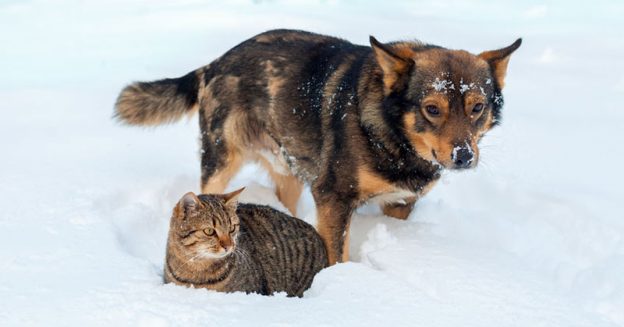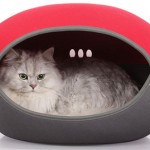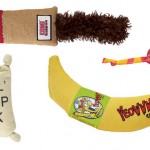Last updated: July 27th, 2023
As the temperature starts to plummet, we are lucky enough to adapt easily and throw on a couple of extra layers, and cosy up by the fire with a blanket and a hot chocolate. If we’re really lucky, we might be able to look out the window and watch the sprinkles of snow settle on the floor. That is all well and good for us, but what about our pets? Taking precautions and practising good cold weather safety is the best way to help our pets transition safely into winter and ensure we are keeping our furry, fluffy or feathered family members safe and comfortable as the weather starts to turn.
How animals adapt to the cold
Before we share some cold weather safety tips, we thought it would be a good idea to explain how many animals have natural adaptions to the cold weather. Animals like dogs and cats may grow a thicker, winter coat whilst other animals might gain weight to store an insulating layer of fat underneath their skin to keep warm. Some animals’ metabolism might slow down, and they’ll start to sleep more, or some animals might hibernate completely. You’ve probably heard of other animals migrating to escape the cold weather. All of these natural occurrences help wild animals to survive through the coldest of winters.
Pets though, no matter what animals you’ve chosen to make a family pet, aren’t living in their natural habitats and do not live in their wild states. Your pet bird can’t fly to escape the chill and others might struggle to embrace their natural adaptions due to temperature changes throughout the day thanks to central heating or fireplaces. Most of the pets we keep would never naturally be found in our homes therefore their natural adaptations might not be adequate to protect them from winters. Fortunately, there are many ways we can help to keep our pets safe through the winter, no matter how cold it might get or how much snow or ice might settle.
Keeping pets safe in the winter
These tips will help to keep your pets safe and warm in the winter and are all good practise to ensure that you are doing the best for your pets during the cold months. Different tips will apply to different animals and some animals are more toughened to the cold weather than others, so you’ll need to decide which ones best apply to your pets. Understanding how to help animals keep warm in the winter is the first stage of protecting them.
Don’t shave your pet’s coat in the winter
Just like when you start to cut your own hair, you notice the chill around your neck or your ears, your pet will notice the change. A shorter coat might be helpful for pets in the summer heat, but it is very important to not shave your pet’s natural thicker and longer coat in the winter. Extensive shaving and cutting will cut down your pet’s natural insulation. Instead, give them a slight trim around the paws, rear end and any overly feathered limbs to minimise the accumulation of snow and ice balls and reduce the chance of knots and discomfort.
Brush your pet, but cut down on the baths
Regular brushing will ensure your pet has a beautifully groomed coat and reduce the chance of tangled and matted fur. It’s important to keep the knots and tangles away as they can disrupt the natural insulating properties. Whilst it’s important to brush, regular bathing is not such a good idea. Try not to bathe your pet too often during the winter because the dampness as they dry off can make them susceptible to chills and hypothermia.
Rinse and dry paws after walks
Salts and de-icing chemicals that are put down to reduce snow and ice on the pavements and roads can be incredibly dangerous for your pet, not only can they cause irritation, but if ingested, they can be incredibly harmless for your pet, so harmless it can cause death in pets. Even after a short walk, always rinse your pet’s paws with warm water and thoroughly dry them off to remove any toxic properties. Whilst you’re doing this, it’s a good idea to check their paws for any chapping, dry skin, cuts or cracks that can be uncomfortable for pets. If your pet is short, you might need to rinse and dry their belly too if their fur has been dragged through the snow.
Keep chemicals out of reach
This should go without saying, but all cold weather chemicals, like window defreeze, salts, de-icers and antifreezes should all be kept well out of the way of your pets. Ensure that your pet is not in the vicinity when using these products too. These chemicals are highly toxic for your pets and ingesting a small amount can be fatal. Always wash your hands thoroughly after handling these products to ensure that your pet doesn’t lick them off.
Provide a warm sleeping spot
Pets need a cosy and comfortable spot to relax during the winter months. Providing an extra blanket for their bed, or deeper bedding during the winter months is ideal for better insulation. Be sure the bed is out of the way of drafts. Feel free to check out our review of some of the best cat beds.
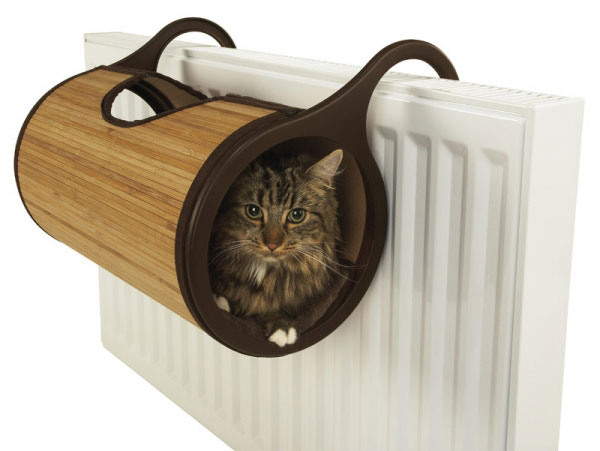
If your pet spends a lot of time outdoors, make sure they have access to somewhere sheltered for example a shed or garage, where they can get out of the cold.
Drinking water for your pet
Although cold water and water with ice cubes in is a good choice in the heat, it’s best to swap for room temperature water in the winter. If you leave water outside in a bowl for your pets, make sure this doesn’t freeze over.
Use reflective collars, leashes and clothing
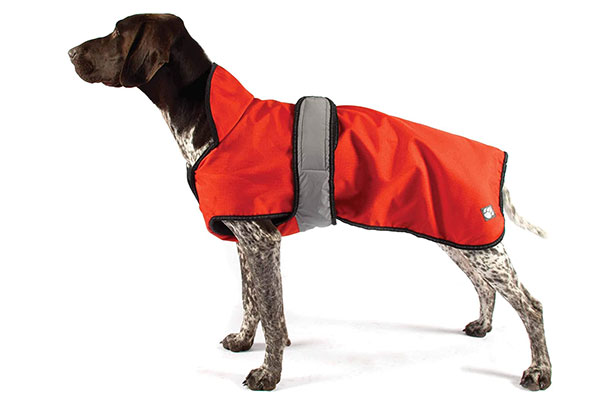
As the shorter days start to draw in, it can get dark quickly and can catch you off guard. Be sure that your pet has some reflective material to make them visible. A dog coat can also help keep your pet warm and dry during winter conditions – you can check out our review of the best waterproof dog coats.
Take shorter walks
Instead of having long walks in the bitter cold elements, try to take shorter walks and play more indoors instead.
Stay off icy surfaces
When on walks, ensure to keep your pets away from icy surfaces as much as possible as these can cause slips and fall accidents. If possible, try not to take walks during icy conditions and just stick to letting your pet relieve themselves and then playing inside instead. Ice shards can also be dangerous for delicate paws.
Be careful not to overheat your pet
It can be tempting to whack the heating up and have the fire full ablaze but be careful of overheating. Take care that your pet is not suffering from too much heat. Be careful that your pet isn’t in reach of open flames, like candles, fireplaces and portable heaters which could lead to burns or fires. Always check the candle scents that you’re lighting too as some scents can be toxic for pets.
Cold weather can be uncomfortable or dangerous for pets so please make sure you are taking the correct steps to keep your companions safe and comfortable no matter how much the temperature drops.

